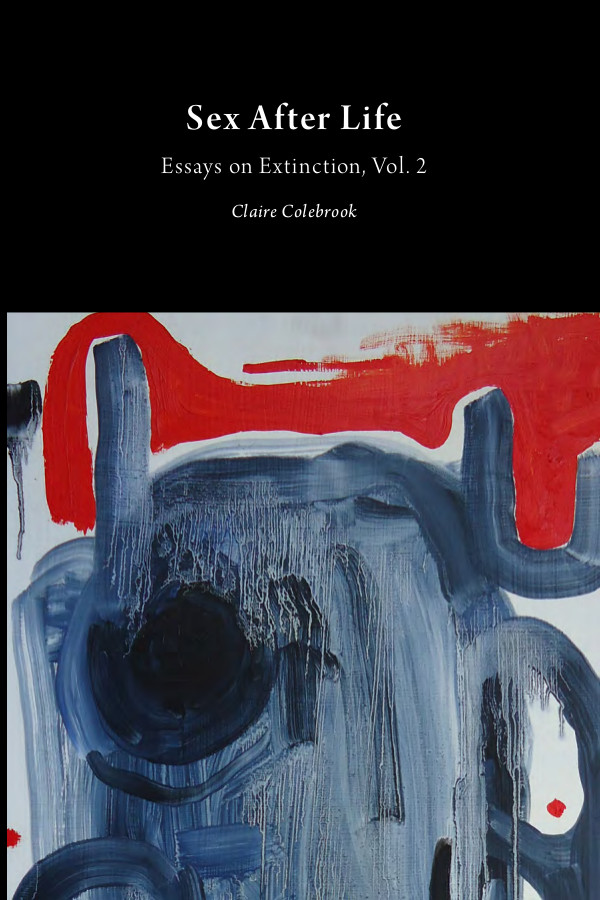Claire Colebrook: Essays on Extinction, 2 vols.: Death of the PostHuman & Sex After Life (2014)
Filed under book | Tags: · aesthetics, anthropocene, autopoiesis, critical theory, death, ecology, feminism, life, philosophy, posthuman, posthumanism, queer theory, sex, vitalism


“Death of the PostHuman undertakes a series of critical encounters with the legacy of what had come to be known as ‘theory,’ and its contemporary supposedly post-human aftermath. There can be no redemptive post-human future in which the myopia and anthropocentrism of the species finds an exit and manages to emerge with ecology and life. At the same time, what has come to be known as the human–despite its normative intensity–can provide neither foundation nor critical lever in the Anthropocene epoch. Death of the PostHuman argues for a twenty-first century deconstruction of ecological and seemingly post-human futures.”
“Sex After Life aims to consider the various ways in which the concept of life has provided normative and moralizing ballast for queer, feminist and critical theories. Arguing against a notion of the queer as counter-normative, Sex After Life appeals to the concept of life as a philosophical problem. Life is neither a material ground nor a generative principle, but can nevertheless offer itself for new forms of problem formation that exceed the all too human logics of survival.”
Publisher Open Humanities Press, 2014
Critical Climate Change series
Creative Commons BY-SA 3.0 License
ISBN 978-1-60785-299-5 (v1), 978-1-60785-300-8 (v2)
243 & 263 pages
Vol. 1: HTML, PDF, PDF, PDF
Vol. 2: HTML, PDF, PDF, PDF
W. J. T. Mitchell, Mark B. N. Hansen (eds.): Critical Terms for Media Studies (2010)
Filed under book | Tags: · aesthetics, autopoiesis, body, communication, cybernetics, image, information theory, language, law, mass media, media, media studies, media theory, memory, networks, posthuman, software, technology, writing

“Part of a larger conversation that engages culture, technology, and politics, this collection of essays explores critical language for dealing with the qualities and modes of contemporary media. The essays, commissioned expressly for this volume, are organized into three interrelated groups: “Aesthetics” engages with terms that describe sensory experiences and judgments, “Technology” offers entry into a broad array of technological concepts, and “Society” opens up language describing the systems that allow a medium to function.”
Contributors: Johanna Drucker (Art), Bernadette Wegenstein (Body), Bill Brown (Materiality), Bernard Stiegler (Memory), Caroline Jones (Senses), Eugene Thacker (Biomedia), Bruce Clarke (Communication, Information), N. Katherine Hayles (Cybernetics), Geoffrey Winthrop-Young (Hardware / Software / Wetware), John Johnston (Technology), David Graeber (Exchange), Cary Wolfe (Language), Peter Goodrich (Law), John Durham Peters (Mass Media), Alexander R. Galloway (Networks), David Wellbery (Systems), Lydia H. Liu (Writing), and W. J. T. Mitchell and Mark B. N. Hansen (Image, Time and Space, New Media).
Publisher University of Chicago Press, 2010
ISBN 0226532666, 9780226532660
376 pages
Bruce Clarke, Mark B. N. Hansen (eds.): Emergence and Embodiment: New Essays on Second-Order Systems Theory (2009)
Filed under book | Tags: · autopoiesis, body, cognition, complexity, cybernetics, emergence, neocybernetics, science, systems theory

“Emerging in the 1940s, the first cybernetics—the study of communication and control systems—was mainstreamed under the names artificial intelligence and computer science and taken up by the social sciences, the humanities, and the creative arts. In Emergence and Embodiment, Bruce Clarke and Mark B. N. Hansen focus on cybernetic developments that stem from the second-order turn in the 1970s, when the cyberneticist Heinz von Foerster catalyzed new thinking about the cognitive implications of self-referential systems. The crucial shift he inspired was from first-order cybernetics’ attention to homeostasis as a mode of autonomous self-regulation in mechanical and informatic systems, to second-order concepts of self-organization and autopoiesis in embodied and metabiotic systems. The collection opens with an interview with von Foerster and then traces the lines of neocybernetic thought that have followed from his work.
In response to the apparent dissolution of boundaries at work in the contemporary technosciences of emergence, neocybernetics observes that cognitive systems are operationally bounded, semi-autonomous entities coupled with their environments and other systems. Second-order systems theory stresses the recursive complexities of observation, mediation, and communication. Focused on the neocybernetic contributions of von Foerster, Francisco Varela, and Niklas Luhmann, this collection advances theoretical debates about the cultural, philosophical, and literary uses of their ideas. In addition to the interview with von Foerster, Emergence and Embodiment includes essays by Varela and Luhmann. It engages with Humberto Maturana’s and Varela’s creation of the concept of autopoiesis, Varela’s later work on neurophenomenology, and Luhmann’s adaptations of autopoiesis to social systems theory. Taken together, these essays illuminate the shared commitments uniting the broader discourse of neocybernetics.”
Contributors. Linda Brigham, Bruce Clarke, Mark B. N. Hansen, Edgar Landgraf, Ira Livingston, Niklas Luhmann, Hans-Georg Moeller, John Protevi, Michael Schiltz, Evan Thompson, Francisco J. Varela, Cary Wolfe.
Publisher Duke University Press, 2009
Science and Cultural Theory series
ISBN 0822391384, 9780822391388
xiii+296 pages
Reviews: Ramesh Mishra (MetaPsychology, 2010), Ana Teixeira Pinto (Int’l Studies in the Philosophy of Science, 2011), Jon Goodbun (Radical Philosophy, 2011), Peter Cariani (Constructivist Foundations, 2010).
PDF (updated on 2020-4-17)
Comment (0)
